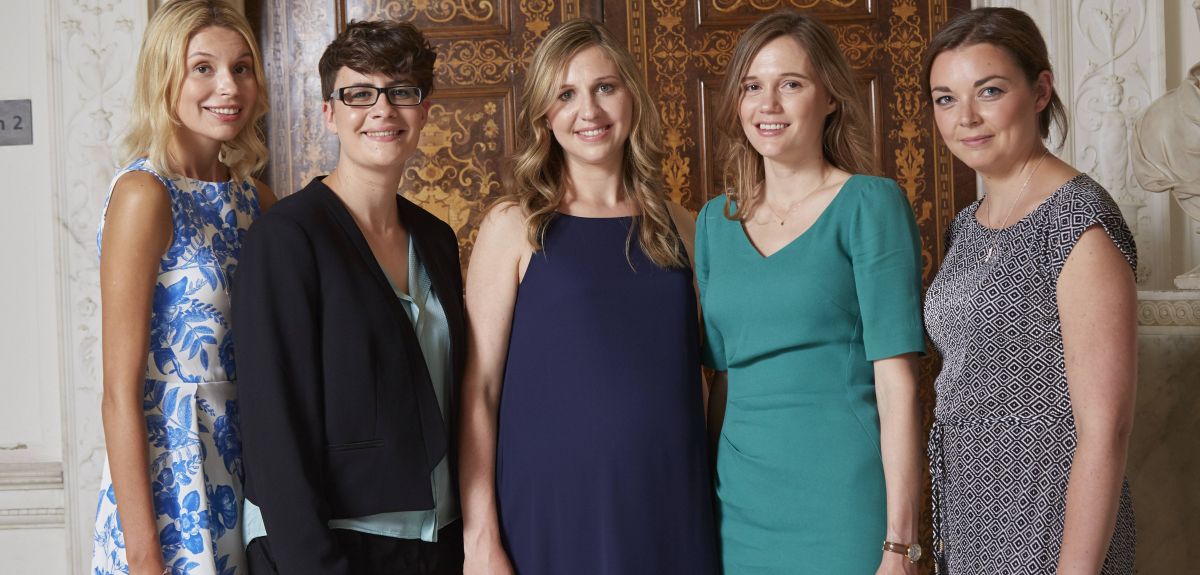
Image credit: L'Oréal-UNESCO
Two Oxford scientists selected for 'Women in Science' Fellowships
Two of Oxford's most promising female scientists have been named among five new Fellows of the L'Oréal-UNESCO UK and Ireland For Women in Science programme.
Dr Maria Bruna, of Oxford Mathematics (and a member of the Computational Biology Group in the Department of Computer Science), and Dr Sam Giles, a palaeobiologist in Oxford's Department of Earth Sciences, were selected from 400 applicants for the Fellowships, which were announced at a ceremony hosted by the Royal Society.
The programme aims to support and help increase the number of women working in science and is designed to provide flexible financial help to outstanding female postdoctoral scientists to continue research in their chosen fields. The fellowships, worth £15,000 each, can be spent on whatever the winners may need to continue their research.
Dr Bruna and Dr Giles spoke to Science Blog about their work, their plans for the Fellowships, and the subject of women in science.
Dr Maria Bruna, Oxford Mathematics
'I work on developing mathematical methods to describe systems of interacting particles. These could be used to represent small-scale systems, such as a group of cancer cells in a tumour, or larger-scale systems such as animal flocks. The goal of my research is to understand how collective behaviour emerges from simple interactions between individuals. For example, how do the properties and behaviour of the individual cancer cells determine how the tumour will evolve?
'I can't remember how I first became interested in science, but I've always been a very curious person. I liked all sciences but in particular numbers and building things. That is why I started my studies with an engineering degree, followed by a maths one. Since then, I've found my place in applied mathematics, which allows me to combine my passion for maths with my engineering side.
'I'm very happy and excited to have been awarded this Fellowship. It comes at an ideal time for me, as I'm on maternity leave for the birth of my first son, and I will use the Fellowship to kickstart my research on my return from that.
'Awards like this one are very important to raise awareness of women in science and to help redress the gender imbalance in most sciences. While we have a lot more women in the University now than 50 years ago, I feel that in some sense the culture in academia (with long hours, more administration, scarcity of jobs) is becoming harsher, especially for women and people with young families. Initiatives like the L'Oréal-UNESCO awards, which offer practical support such as paying for childcare costs, are an excellent way to make things a bit easier for us.'
Dr Sam Giles, Department of Earth Sciences
'My research focuses on animals with backbones (vertebrates), a group that today includes over 60,000 species. Vertebrates have an evolutionary history stretching back over half a billion years, so it's really important to look at the fossil record to understand how the group became so hugely successful. Many major innovations, as well as important anatomical features, are found within the braincase, a kind of bony box that sits within the head and houses the brain and sensory organs.
'By using x-ray tomography, it is possible to "virtually" cut through the specimens and produce 3D reconstructions of the brain and braincase anatomy. Comparing these structures between key living and extinct animals allows for major evolutionary events to be put into context.
'I've been interested in science since I was very young, and I used to love reading science books and looking for different kinds of rocks and fossils. When I was at school, my favourite subject was geography – especially physical geography and the study of glaciers and volcanoes. I studied geology at university in Bristol and managed to get a (fairly boring) summer job in the palaeontology lab. As I got more involved in the work (basically picking microscopic fossil fragments out of a very big box), I read around the subject more and got more interested. I also got the chance to work on a beamline at the Swiss Light Source, a large particle accelerator that allows you to use X-rays to look at really tiny structures. This made me want to keep working in the field, and I applied for a DPhil at the University of Oxford. After finishing that, I started a Junior Research Fellowship at Christ Church, Oxford.
'I'm really happy and grateful to have been awarded this Fellowship, especially as it's so flexible, meaning I can use it in multiple ways to help my research: I can pay for my daughter's childcare for the next year, as well as buy expensive computer equipment and travel to international conferences. My plan is to stay in academia and hopefully get a lectureship somewhere.'